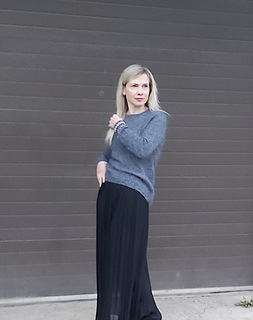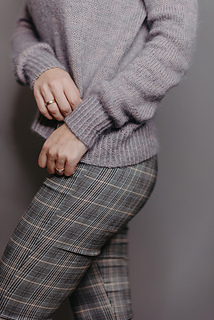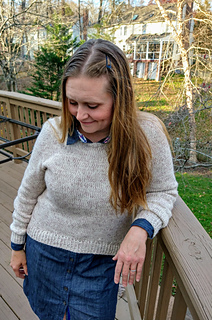patterns >  Zaneteknits
Zaneteknits
> Accentuating Crewneck

















Accentuating Crewneck
Join my mailing list and be the first to know about new pattern releases, exclusive discounts, events and other news: https://go.zaneteknits.com/news
A very simple and timeless crewneck sweater that accentuates you without distractions. It has a relaxed body without any shaping so that it fits you no matter what. A couple of subtle details that set this sweater apart from others are the high-low hemline and a slight puff in the close-fitting sleeves, adding a hint of romance and femininity. The perfect sweater for any occasion.
Sizes: 75 (85, 95, 105) ((115, 125, 135, 145))
Finished bust circumference:
- 94 (106, 115.5, 124.5) ((134, 146, 155.5, 164.5)) cm
- 37½ (42½, 46¼, 49¾) ((53½, 58½, 62¼, 65¾))’’
Designed to be worn with 15-26 cm / 6-10” ease, to fit busts with circumference:
- 70-79 (80-89, 90-99, 100-109) ((110-119, 120-129, 130-139, 140-149)) cm
- 28-32 (32-36, 36-40, 40-44) ((44-48, 48-52, 52-56, 56-60))”
To choose the right size for you I suggest you refer to the schematic measurements and also consider the B: Shoulder to shoulder and D: Upper arm circumference measurements.
Yarn: Fingering weight wool and a strand of mohair, held together, depending on the length of the sweater, of each yarn allow approximately:
- 790 (870, 940, 1010) ((1080, 1180, 1260, 1340)) m
- 860 (950, 1030, 1100) ((1180, 1290, 1380, 1470)) yds
Yarn used in sample (Size 85) is 220g of hand-spun (100% Merino wool, 400m/100g), and 4 balls of Drop Kid Silk Mohair (210m/25g), Ash grey colourway, held together.
I recommend using a blend of fingering yarn and lace weight mohair, but you can substitute with a DK or Aran weight yarn.
Gauge: 17 sts & 24 rows = 10 cm / 4” in Stockinette stitch, blocked.
Remember to make a swatch and ensure you get the required gauge. If your gauge is different from the one stated above, adjust needle size, otherwise, you risk that your finished garment will not fit right. Block your swatch the same way you plan to block your sweater and let it fully dry before measuring the gauge.
Suggested needles:
- 4.5mm (US 7) circulars 60cm / 24”
- 3.25mm (US 3) circulars or DPNs for small circumference knitting
Notions: Stitch markers, row counter, scissors, tape measure, stitch holders or waste yarn, tapestry needle, removable stitch markers or bobby-pins.
Techniques used: Cable cast-on, lifted increases, Japanese short rows.
Difficulty: Intermediate.
Construction notes: The sweater is worked seamlessly in the round from the top down. Back neckline stitches are cast-on, shoulders and neckline are shaped using short rows and lifted increases. Stitches for each front shoulder are picked up along the back shoulders and worked separately with increases shaping the front neckline. Back and front are joined together, simultaneously stitches for sleeves are picked up along the shoulder edges of back and front, and the yoke is continued in the round down to underarm, then body and sleeves are separated and worked separately in the round all the way to the hem and cuffs.
Other notes: For this project, I recommend using Japanese Short rows or the most invisible short-row technique you know. Instructions do not specify closing short row gaps, instead, closing is implied whenever working over turning points.
LV
Ļoti vienkāršs un nemainīgi stilīgs džemperis ar apaļu kakla izgriezumu, kas nenovērš uzmanību no valkātāja. Džemperim ir brīvs piegriezums, un tas piestāvēs jebkuram. Pagarināta muguras daļa, pieguļušas, bet galos nedaudz pufīgas piedurknes, piešķir džemperim romantisku un sievišķīgu gaisotni. Perfekts katram dzīves gadījumam.
Izmēri: 75 (85, 95, 105) ((115, 125, 135, 145))
- Pabeigta džempera krūšu apkārtmērs: 94 (106, 115.5, 124.5) ((134, 146, 155.5, 164.5)) cm
- Paredzēts valkāšanai ar 14-26 cm ērtuma pielaidi. Krūšu apkārtmēriem: 70-79 (80-89, 90-99, 100-109) ((110-119, 120-129, 130-139, 140-149)) cm
Lai izvēlētos piemērotu izmēru, iesaku ņemt vērā arī mērus B: No pleca līdz plecam un D: Augšdelma apkārtmērs.
Dzija: Plāna (fingering weight) vilna kopā ar mohēras pavedienu, atkarībā no džempera garuma, no katras aptuveni nepieciešami 790 (870, 940, 1010) ((1080, 1180, 1260, 1340)) m.
Dzijas, kas izmantotas paraugā (Izmērs 85), ir 220g ar rokām vērptas dzijas (100% Merino vilna, apm. 400m/100g), un 4 fices Drops Kid Silk Mohair (210m/25g), Ash grey krāsojums, turot kopā.
Es iesaku izmantot plānu vilnas dziju kopā ar mohēras pavedienu, bet iespējams aizvietot ar vienu paveidienu vidēji biezas dzijas(DK vai Aran weight).
Adīšanas blīvums: 17 v & 24 rindas = 10 cm gludajā labiskajā adījumā, pēc mitrās apstrādes.
Neaizmirstiet uzadīt paraugu un pārliecināties, ka iegūtais adīšanas blīvums ir atbilstošs. Ja iegūtais blīvums atšķiras no prasītā, pielāgojiet adatu izmēru, jo pastāv iespēja, ka pabeigtais džemperis neatbildīs vēlamajam izmēram. Pirms adīšanas blīvuma noteikšanas, noteikti vēlams veikt mitro apstrādi paraugam tādā pašā veidā, kā plānots veikt gatavam džemperim.
Ieteicamās adatas:
- 4.5mm apļa adatas, 60cm.
- 3.25mm apļa adatas vai zeķu adatas mazu apkārtmēru adīšanai.
Papildus nepieciešams: Marķieri, rindu skaitītājs, šķēres, mērlenta, valdziņu turētāji vai pagaidu dzijas pavedieni, lāpāmadata, noņemami marķieri vai matu sprādzes (Japāņu nepabeigtām rindām).
Izmantotās tehnikas: Pieaudzēšana no malējā valdziņa (cable cast-on), pieaudzējumi no iepriekšējās rindas (lifted increases), Japāņu nepabeigtās rindas (Japanese short rows).
Sarežģītība: Vidēja.
Konstrukcijas piezīmes: Džemperis tiek adīts bez vīlēm aplī, no augšas uz leju. Sākotnēji tiek uzmesti valdziņi mugurpuses kakla izgriezumam, pleci un kakla izgriezums tiek adīti, izmantojot nepabeigtās rindas un pieaudzējumus no iepriekšējās rindas. Valdziņi abiem priekšpleciem tiek uzcelti gar mugurpuses plecu līnijām un tiek adīti atsevišķi, vienlaicīgi ar pieaudzējumu palīdzību veidojot kakla izgriezumu. Mugurpuse un priekšpuse tad tiek savienoti, vienlaicīgi tiek uzlasīti valdziņi piedurknēm gar plecu līniju malām. Pēc savienošanas teilis tiek adīts aplī līdz padusēm, tad tiek atdalīti piedurknes un stāvs. Gan stāvs, gan piedurknes tiek adīti aplī līdz pat apakšmalai un aprocēm.
Citas piezīmes: Šim projektam iesaku izmantot Japāņu nepabeigtās rindas vai jums zināmo visnemanāmāko nepabeigto rindu metodi. Instrukcijas nenorāda, kādā veidā ir jāslēpj pagriezienu vietas, to paslēpšana ir jāveic pie sastapšanas.

57773 projects
stashed
47894 times
22513 projects
stashed
16408 times
2863 projects
stashed
1728 times
80332 projects
stashed
39236 times
12390 projects
stashed
8379 times
1919 projects
stashed
1080 times
6235 projects
stashed
5048 times
14487 projects
stashed
16416 times
3689 projects
stashed
3905 times
932 projects
stashed
643 times
862 projects
stashed
736 times
2960 projects
stashed
2999 times
2369 projects
stashed
1166 times
477 projects
stashed
327 times
4882 projects
stashed
2561 times
1251 projects
stashed
1171 times
550 projects
stashed
511 times
1881 projects
stashed
1905 times
260 projects
stashed
243 times
- First published: December 2020
- Page created: December 23, 2020
- Last updated: April 3, 2025 …
- visits in the last 24 hours
- visitors right now





